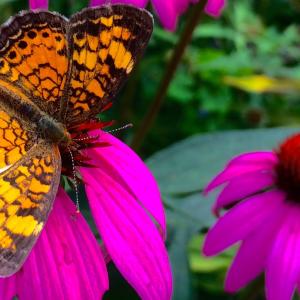

The grounds of Liberty Hall Historic Site feature four acres of lawns and gardens bordering the Kentucky River. The grounds are open to the public from dawn until dusk. We are now a featured stop on The Kentucky Garden Trail! Make sure to collect your passport or sticker from the Museum Store during your next visit!
The gardens combine historical and contemporary features. Behind Liberty Hall, a four-square garden with brick- and boxwood-lined grass paths and extensive flower beds evokes early American formal gardens. Inspired by a drawing made by a family member in the 1920s, this garden includes flowers and shrubs mentioned in family papers and native Kentucky plants. To learn more about the garden’s history, click here.
Recent additions to the grounds include the Mothers’ Garden and Euphemia’s Butterfly Garden. Located on the Orlando Brown House lawn, the Mothers’ Garden is a garden which honors mother figures and is funded by donations. To learn more about honoring a loved one through this garden, click here.
The monarch waystation located on the Orlando Brown House grounds is named for two girls named Euphemia Brown who lived here in the early 19th century. The first was Euphemia Helen Brown (1807-1814), the only daughter of John and Margaretta Brown, the first residents of Liberty Hall. After her death at age seven, Margaretta Brown was said to take solitary walks in hopes of seeing “her angel child.” The second Euphemia H. Brown (1831-1891) was the first child of Orlando and Mary Watts Brown. As an infant, she was ill with scarlet fever that may have caused brain damage. She spent over half of her life in institutions in northern Kentucky, where she died of pneumonia in 1891.

This garden features milkweed, asters, and other plants that appeal to Monarchs and other butterflies. Monarchs—which look a lot like Kentucky’s state butterfly, the Viceroy—winter in Mexico and the southern United States and fly north in the spring to lay eggs. The black, yellow, and white-striped caterpillars that hatch from those eggs feed, pupate, and emerge as butterflies, which mate and lay eggs multiple times before returning south.
Other features in the LHHS gardens include many old trees and the variety of birds that enjoy them—from hummingbirds to hawks. Catalpas planted in 1800, 1900, and 2000 flank Liberty Hall. Trees at the back of the property overlooking the Kentucky River include a sycamore, a coffee tree, and other Kentucky natives.
Self-Guided Garden and Grounds Tour
To tour the garden on your own, visit the stops on this downloadable diagram below to learn about two centuries of Brown family and garden history. You will learn about the evolution of the grounds from food production to flower gardens.
Self-Guided Garden & Grounds Tour
Volunteers
We are always looking for garden volunteers to help out around our grounds and gardens. If you are interested, please complete the form by clicking the button below.
Other Garden Guests
Leashed dogs are welcome on the grounds. We ask any owners that bring their dogs onsite to please pick up and remove any pet waste created by their pet during your visit. This includes any garden area as well as the brick sidewalks.
We encourage photography, but professional photographers are asked to purchase a pass. To learn about renting grounds for weddings and other events, click here.
Accessibility
The garden includes some uneven ground, and stone and brick paths. Wooden and stone benches are provided as occasional resting places.
